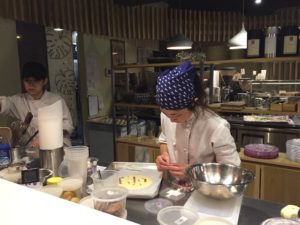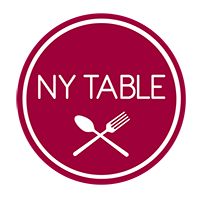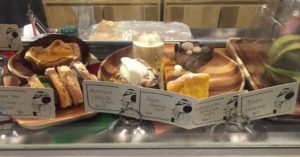
Tomoko Kato (right) decorates a cake with dried rosebuds while Tia Yen (left) mixes cake batter. Photo: Sanam Yar.
“Moshi moshi,” chirped Tomoko Kato into the phone, Japanese for “hello,” as she dusts her flour-coated hands on her apron.
Kato, 41, is the owner and pastry chef of Patisserie Tomoko, a Williamsburg bakery and dessert bar specializing in traditional French pastries infused with Japanese elements, the sort of place that’s quiet even when it’s packed. Tomoko opened in 2012, after a friend in the industry warned Kato that she had to open her own place before she turned 40. So Kato took a chance, and $100,000 of savings, and set up shop.
“If you do it after 40, you don’t have the stamina,” she said. Kato had spent eight years as manager and chef at Cha-An teahouse on the Lower East Side, which she helped open, but her schedule there was so busy she knew she “didn’t want to do it for life.”
Kato, slight in frame, keeps her dark hair tucked beneath colorful, patterned bandanas that accent her freckles and high cheekbones. She’s part of New York City’s small Japanese community, which makes up only 0.60 percent of the city’s total immigrant population. Kato shrugs when she considers the small number, saying it is sad but that most people she knows back home are “happy to stay where they are.” Around ten percent of her clients are Japanese.
Born in Hokkaido, Kato studied pastry arts at a Kyoto culinary school and worked in Japan prior to settling in Williamsburg. Kato knew she wanted to be a pastry chef by junior high, inspired by years of observing her mother bake at home, but never envisioned settling down in the states long-term. Her interest in the United States began after she visited San Francisco and Los Angeles when she was 19, spending her savings on plane tickets and staying at friends’ homes. “It was my first time out of Japan by myself,” said Kato, piping chocolate ganache into macaron shells before squishing the pastel cookies together. “I met many great people, even the bus driver was nice to me.”
After a few more visits, she decided she wanted to spend a couple of years in the U.S. Kato relished the anonymity she experienced in the city. In New York, “no one cares who I am. If they wanted to know what I’m doing, they can come to me and ask,” she laughed.
But in Hokkaido, an island brimming with swathes of unspoiled nature, one that houses only five percent of Japan’s population, “everyone cares, it’s like a very small neighborhood.” Still, Kato’s outdoor-based upbringing has carried over to her New York life; she goes hiking whenever she can.
Kato’s parents were unfazed when she told them she was moving to the U.S. She had been very independent since high school, and her parents only insisted that if she left, she’d accept responsibility for herself and her new life.
Three years working at a Kyoto pastry shop helped Kato save enough money to move to New York, where she stayed in a youth hostel, and knew little of the city other than the location of the school where she would take English classes. She eventually landed her first internship at the Russian Tea Room as a pastry line cook. Years later, she’d meet her husband, a lawyer, at a Williamsburg coffee shop. He chipped in some of his savings to help her open Patisserie Tomoko.
The bakery, tucked away in a line of shops on the ground floor of a luxury apartment building, is a minimalist’s dream. A glossy U-shaped counter overlooks the open kitchen, and the overhead lights were designed to look like dollops of whipped cream. The interior, clean and mostly white, is dotted with greenery.
Kato has made a career out of paying attention to details, and the one design element she was adamant about having was koshi, traditional Japanese wooden panels that line the walls almost like a curtain. Asked if she had koshi in her own home as a kid, she smiles ruefully, “More like I wished I had it.” She says her family life was very simple growing up.
On a Wednesday evening, a mix of customers steadily drifts in and out of the shop, pausing to peer at the ornate pastries behind the display case. It’s pouring rain outside, and Etta James gently plays in the background. A small child, seated at the counter next to his mother, eagerly grabs a slice of pumpkin cheesecake bigger than his face and bites into it, repeatedly proclaiming how good it is.
“They always come in and he always gets the same cake,” said the barista, smiling at the boy.
Kato and her team are a choreographed dance, constantly in motion, slipping easily around each other in the kitchen. Her staff is diverse: Americans, a Frenchman, and one Japanese staff member, among others. She chats with Tia Yen, a pastry chef who’s been at the shop for almost a year, about a viral video of an Olympic Russian figure skater’s Sailor-Moon inspired routine, looking amused.
Yen, 26, intends to return to her home of Taiwan eventually, but her priority after graduating from culinary school in New York was to find a place to work that “wasn’t your traditional French pastry shop.”
“I wanted to do something that was popular and that I could do in Taiwan as well,” she said, noting that the Asian ingredients and flavors the shop uses are something she could incorporate back home. She mentions one customer, who loves the shop’s black sesame red bean mochi so much that he orders 60 pieces every month.
The shop’s best-seller is mille crepe cake, and Kato methodically spreads chocolate frosting on layer after layer of crepe. The fun part of baking, she says, is inventing different interpretations of classic sweets, like mochi with earl grey infused chocolate, matcha mille crepe cake and black sesame crème brûlée.
Kato, who has no children and regularly calls her family back home, has changed her mind about the future: she now says she’d only consider moving back if she was retired. “It’s good to live outside Japan, to get an outside perspective,” she says. “Now, I much more appreciate being Japanese.”
“You know, I’m not good at communication, but with the open kitchen, I’m learning properly speaking little by little with customers,” she says. “It wouldn’t have happened if I had stayed in those kitchens in the back of the restaurant.”
For now, Kato, is content where she is. “I don’t make plans five years, 10 years from now,” she says. “I’m ready for what happens now. Life, it happens, then you make decisions.”
Tags: Brooklyn, dessert, french, immigrant, Japan


Your Comments